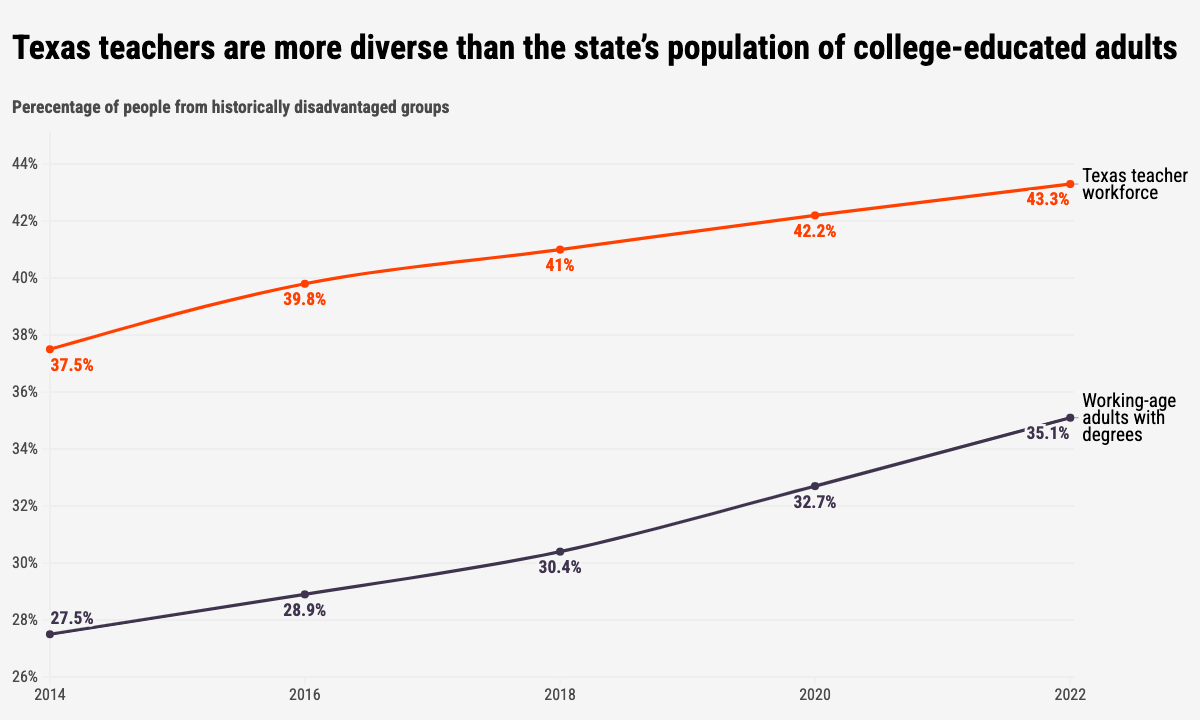California, Texas and D.C. Are Tops in Teacher Diversity, Report Finds
While educator diversity is slowing across the country, these 3 regions are pushing ahead. But researchers have questions about how

Get stories like this delivered straight to your inbox. Sign up for The 74 Newsletter
California, Texas and Washington, D.C., lead the nation in teacher diversity, according to a recent report by the National Council on Teacher Quality.
While the nation’s college-educated workforce overall is diversifying more quickly than the teaching pool, the NCTQ found that California, Texas, and Washington, D.C., are following the opposite trajectory. But the nonprofit questions some of the methods used to increase diversity, such as alternative pathways or lower standards for teacher certification, said Ron Noble, the council’s chief of teacher preparation.
“We found that places like Texas are achieving [more teacher diversity], but with policies that have us concerned about the long-term health of the teacher pipeline,” Noble said. “California and Washington, D.C., offer potential bright spots that might not have that same pitfall.”
NCTQ’s report follows its December launch of a teacher diversity dashboard that tracks the racial makeup of U.S. educator corps from 2014 to 2022. Noble said the organization is focusing on educator workforce diversity because employing teachers of color improves academic, social, emotional and behavior outcomes for students.
“We really want states to be deliberate and intentional in — and careful how they go about — achieving the goal of a diverse workforce,” Noble said.
Teachers from historically disadvantaged groups in the U.S. make up nearly 23% of working-age adults with degrees but 21% of the teacher workforce, according to the dashboard.
In Texas, 35% of college-educated adults are from historically disadvantaged groups, compared with 43% of teachers. But researchers found that behind the high diversity number were flawed alternative certification programs and uncertified teachers — both of which became more common with educator shortages during the pandemic.
In the 2021-22 school year, 51% of Texas teachers completed alternative certification programs, compared with an average of 19% in other states, according to NCTQ. Alternative pathways are more diverse than traditional programs: One study found that Black Texas teachers were more than three times as likely to pursue alternative certification than a more common route like a bachelor’s degree.
Noble said researchers found that the majority of alternative programs in Texas are fully online and that graduates can become teachers with little to no classroom experience. A 2024 Texas Tech University study found that online alternative pathways have a higher turnover rate than other teacher preparation programs.
“They are thrown right into a high-stakes environment,” he said. “It’s not surprising that there are people leaving the profession.”
The number of uncertified teachers is also growing in Texas classrooms. Last year, state data reported that 34% of newly hired teachers in Texas were uncertified. The NCTQ report says racial demographics of uncertified teachers aren’t tracked, making it hard for policymakers to understand the impact on the future diversity of the educator workforce.
In California, nearly 33% of the teachers come from historically disadvantaged groups, compared with 27% of college-educated adults.
The NCTQ report says California’s effort to prioritize teacher diversity, invest in educator training and track industry data are reasons why diversity rates are higher than the norm. The state has invested more than $1 billion in recent years to strengthen the teacher workforce. Advocates have built a diversity road map and plan to launch a teacher training and retention dashboard later this year to track demographic and employment data.
NCTQ said in its report that California has lowered standards for teacher candidates to enter the profession. A bill that passed in June allows for a bachelor’s degree in any subject to be the sole qualifier for admission into most teacher preparation programs.
NCTQ also cited Washington, D.C., for its high diversity rates, though its trendlines are not on the same trajectory as California’s and Texas’s. In 2022, 69% of educators came from historically disadvantaged groups, a drop from 77% in 2020. Adults with college degrees from these groups were reported at 35% in 2022.
“It would be easy to explain away D.C.’s teacher diversity by pointing out that it is a city, not a state, and cities are typically more diverse than states,” the report says. “However, comparing D.C.’s teacher and student demographics to those in other large cities in the United States suggests D.C.’s approach to diversifying the teacher workforce is yielding results.”
The NCTQ report shows that the teacher workforce in Washington, D.C., more closely mirrored its student population than those of other districts of similar size and student demographics.
About 87% of the district’s student population are people of color, as is 74% of the teacher workforce. Researchers found that Atlanta Public Schools was the only demographically similar district that had a smaller student-to-teacher diversity gap.
The report credits consistent prioritization of educator diversity and innovative teacher preparation pathways for the high percentages in Washington, D.C. The region established “Grow Your Own” preparation programs with university partners and has implemented a centralized hiring process that yields more diverse candidates.
Get stories like these delivered straight to your inbox. Sign up for The 74 Newsletter

;)
